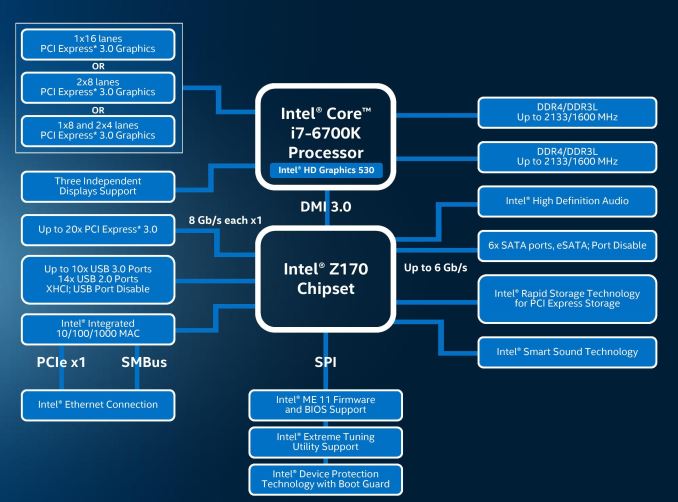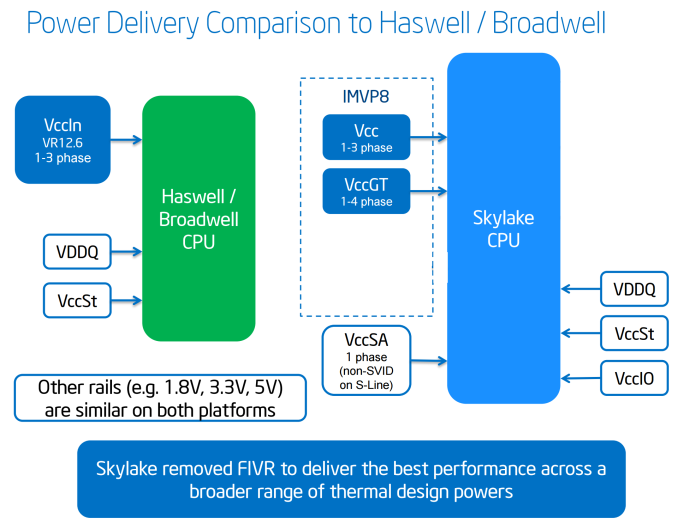The Intel 6th Gen Skylake Review: Core i7-6700K and i5-6600K Tested
by Ian Cutress on August 5, 2015 8:00 AM ESTThe Skylake CPU Architecture
As with any new Intel architecture, the devil is in the details. Previously at AnandTech we have been able to provide deep dives into what exactly is going on in the belly of the beast, although the launch of Skylake has posed a fair share of problems.
Nominally we rely on a certain amount of openness from the processor/SoC manufacturer in providing low level details that we can verify and/or explain. In the past, this information has typically been provided in advance of the launch by way of several meetings/consultations with discussions talking to the engineers. There are some things we can probe, but others are like a black box. The black box nature of some elements, such as Qualcomm’s Adreno graphics, means that it will remain a mystery until Pandora’s box is opened.
In the lead up to the launch of Intel’s Skylake platform, architecture details have been both thin on the ground and thin in the air, even when it comes down to fundamental details about the EU counts of the integrated graphics, or explanations regarding the change in processor naming scheme. In almost all circumstances, we’ve been told to wait until Intel’s Developer Forum in mid-August for the main reason that the launch today is not the full stack Skylake launch, which will take place later in the quarter. Both Ryan and I will be at IDF taking fastidious notes and asking questions for everyone, but at this point in time a good portion of our analysis comes from information provided by sources other than Intel, and while we trust it, we can't fully verify it as we normally would.
As a result, the details on the following few pages have been formed through investigation, discussion and collaboration outside the normal channels, and may be updated as more information is discovered or confirmed. Some of this information is mirrored in our other coverage in order to offer a complete picture in each article as well. After IDF we plan to put together a more detailed architecture piece as a fundamental block in analyzing our end results.
The CPU
As bad as it sounds, the best image of the underlying processor architecture is the block diagram:
From a CPU connectivity standpoint, we discussed the DDR3L/DDR4 dual memory controller design on the previous page so we won’t go over it again here. On the PCI-Express Graphics allocation side, the Skylake processors will have sixteen PCIe 3.0 lanes to use for directly attached devices to the processor, similar to Intel's previous generation processors. These can be split into a single PCIe 3.0 x16, x8/x8 or x8/x4/x4 with basic motherboard design. (Note that this is different to early reports of Skylake having 20 PCIe 3.0 lanes for GPUs. It does not.)
With this, SLI will work up to x8/x8. If a motherboard supports x8/x4/x4 and a PCIe card is placed into that bottom slot, SLI will not work because only one GPU will have eight lanes. NVIDIA requires a minimum of PCIe x8 in order to enable SLI. Crossfire has no such limitation, which makes the possible configurations interesting. Below we discuss that the chipset has 20 (!) PCIe 3.0 lanes to use in five sets of four lanes, and these could be used for graphics cards as well. That means a motherboard can support x8/x8 from the CPU and PCIe 3.0 x4 from the chipset and end up with either dual-SLI or tri-CFX enabled when all the slots are populated.
DMI 3.0
The processor is connected to the chipset by the four-lane DMI 3.0 interface. The DMI 3.0 protocol is an upgrade over the previous generation which used DMI 2.0 – this upgrade boosts the speed from 5.0 GT/s (2GB/sec) to 8.0 GT/s (~3.93GB/sec), essentially upgrading DMI from PCIe 2 to PCIe 3, but requires the motherboard traces between the CPU and chipset to be shorter (7 inches rather than 8 inches) in order to maintain signal speed and integrity. This also allows one of the biggest upgrades to the system, chipset connectivity, as shown below in the HSIO section.
CPU Power Arrangements
Moving on to power arrangements, with Skylake the situation changes as compared to Haswell. Prior to Haswell, voltage regulation was performed by the motherboard and the right voltages were then put into the processor. This was deemed inefficient for power consumption, and for the Haswell/Broadwell processors Intel decided to create a fully integrated voltage regulator (FIVR) in order to reduce motherboard cost and reduce power consumption. This had an unintended side-effect – while it was more efficient (good for mobile platforms), it also acted as a source of heat generation inside the CPU with high frequencies. As a result, overclocking was limited by temperatures and the quality of the FIVR led to a large variation in results. For Skylake on the desktop, the voltage regulation is moved back into the hands of the motherboard manufacturers. This should allow for cooler processors depending on how the silicon works, but it will result in slightly more expensive motherboards.
A slight indication of this will be that some motherboards will go back to having a large amount of multiplexed phases on the motherboard, and it will allow some manufacturers to use this as a differentiating point, although the usefulness of such a design is sometimes questionable.












477 Comments
View All Comments
Jaguar36 - Wednesday, August 5, 2015 - link
I still don't see the point in upgrading from Sandybridge let alone anything newer. Its a big chunk of a cash for a new mobo, CPU and memory, all for what, 25%?Cumulus7 - Wednesday, August 5, 2015 - link
Exactly.Usually i suggest an upgrade if you get approximately twice the performance (+100%). But for 25%: forget it! Never!!!
colonelclaw - Wednesday, August 5, 2015 - link
The other way of looking at it is that it's amazing how good the Sandy Bridge numbers hold up, that good ol' 2600k is one of Intel's all-time great CPUs. Be happy you backed a winner!mrcaffeinex - Wednesday, August 5, 2015 - link
I did and I am very happy. It frees up funds to focus on other parts that make a bigger impact like more RAM, a larger SSD, and of course a better video card.This is better than Haswell in several ways and I imagine the overclockers are going to have some fun since they have been given back more options than some of the previous generations. At least it looks like Intel is paying more attention to the enthusiasts this time around, even if they are not the largest target market.
Cellar Door - Thursday, August 6, 2015 - link
Well, I'm glad I held back on the 2600K and 3770K and got haswell!! - So with this kind of reasoning, its a never ending circle.Look at the platform overall, the pcix storage, nvme compatibility, m.2 ports. USB 3.1 which will be all over the place a lot faster then people realize.
At the same speed its 37% faster and "In specific tests, it is even higher" - a good clocking 6700K will be a nice upgrade for anyone with Sandy. Just like Haswell was for Nahelem users.
Seems a perfectly justifiable upgrade.
Kutark - Sunday, August 9, 2015 - link
Eh. I've been wanting an excuse to upgrade from my 2600k. I am an "enthusiast" and building PC's and such is my hobby. So, it's not always just simply the price/perf value proposition. Christmas is coming up and my nephew doesn't have his own PC yet, and also loves to play steam games (he usually does it at his grandparents). So, this gives me an excuse to build a new setup. I still have my GTX 760 laying around that i upgraded to a 980ti. So a 6700k setup would be a nice pairing with the 980ti and should realistically set me for 3-4 years.kmmatney - Wednesday, August 5, 2015 - link
I'm an i5 3570K owner. If I'm going to upgrade, I'd look for an i7-4790K (or even a i7 2600K) on Ebay before completely overhauling my system with this.darkfalz - Wednesday, August 5, 2015 - link
Even that's a waste of money unless you are doing a tonne of Handbrake.mapesdhs - Wednesday, August 12, 2015 - link
No, get a 2700K instead, they oc much better than the 2600K.2700K = 5GHz guaranteed, even with a simple TRUE and one fan (I use the ASUS M4E,
built five so far).
tim851 - Wednesday, August 5, 2015 - link
Agreed. Especially when you factor in that those 25% is peak performance. How often does the average user call on peak performance? I think the most common and frequent scenario for average users to need CPU power is gaming. And here, due to the fact that GPUs are the bottleneck, you won't even get 10%.From an enthusiast point of view, the last 4 years since Sandy Bridge have been disappointing. If not outright worrying.